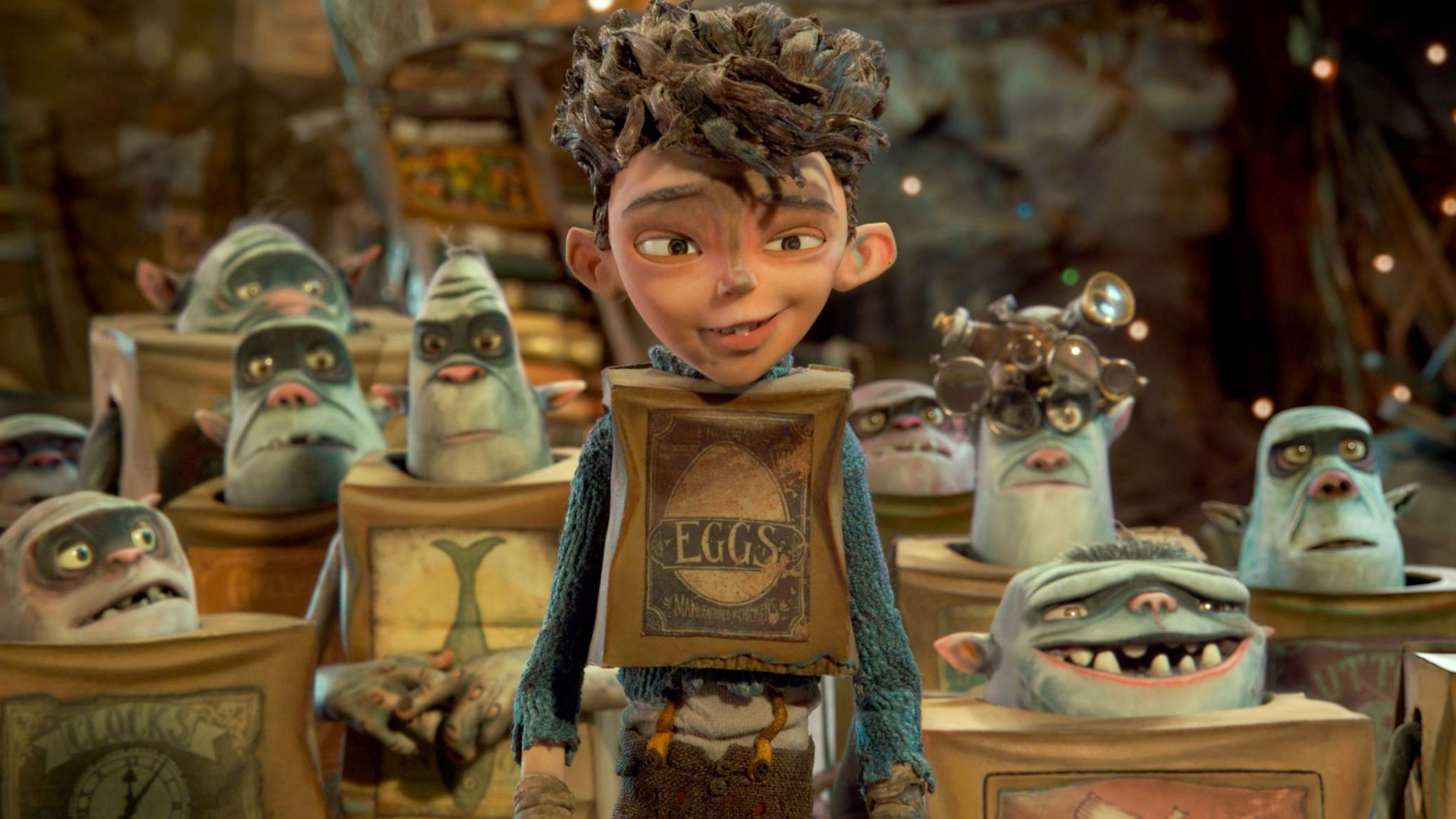
Imagine that ancient Paris had been built on the vertiginous slopes of San Francisco and you’ll picture Cheesebridge, where the highborn dwell in rancid splendor at the top and society’s dregs live underground. These are the boxtrolls, uggy creatures of blue skin and Karloffian visage identified by the discarded boxes they wear. (One is called Fish, another Shoe, a third Fragile.) Hated by the humans above, who have been told that boxtrolls eat children — “Hide your tender and delicious babies!” — these bug-eating beasties are actually sweet, industrious souls. They chatter like the Despicable Me minions, turn the junk they filch from the streets into marvelous gadgets and, when it’s bedtime, assemble themselves communally into a neat, 16-boxtroll cube.
Weirdness with a cutting or cunning edge: The Boxtrolls must be, and is, the latest 3-D feature from Laika, the Hillsboro, Ore., company specializing in stop-motion animation. After the bizarro-world domestic fantasy of Coraline and the boy-who-talks-to-zombies ParaNorman, the new film, directed by Anthony Stacchi and Graham Annable, lets the Laika animators run rampant and have macabre fun. The ghoulish riot of design channels steampunk architecture, Terry Gilliam’s Monty Python animations, Ronald Searle drawings (but more grotesque), Rube Goldberg’s crazy-elaborate inventions and any noirish movie based on a Dickens novel. Which is to say that adults can appreciate The Boxtrolls without feeling stupid, and kids can enjoy pretending to their parents that they’re scared.
For a couple of decades, Nick Park and the stop-motion geniuses at Britain’s Aardman Studio were the undisputed champs of this gruelingly fastidious form of moviemaking, in which plasticine puppets on miniature film sets must be adjusted 24 times for every second of film. Park’s Wallace & Gromit movies and Chicken Run grafted a lovingly sly English wit to this antique technology, making Aardman the finest animation studio not called Pixar. But Park has been dormant lately, and the last Aardman feature, The Pirates! Band of Misfits (2012), lacked the old snazz. That gave Laika an opening with its slightly creepier fare. The Boxtrolls has its penny-dreadful moments, but it’s mostly a larkish stroll through a cemetery where the monsters are the good guys.
In the screenplay by Irena Brignull and Adam Pava, loosely based on Alan Snow’s children’s book Here Be Monsters!, Lord Portley-Rind (voiced by Jared Harris) and his fellow burghers of the White Hat club dine on more varieties of moldy, solidified milk than are referenced in a Monty Python cheese-shop sketch. Craving admittance to this scamorza and broncha society is one Archibald Snatcher (who looks like a carbuncular caricature of Timothy Spall and sounds like Michael Gambon, but is really Ben Kingsley at his most archly villainous). In exchange for a White Hat of his own, he promises to rid the town of the scurvy boxtrolls. Snatcher has mysterious malice in mind, along with a pathetic disability: lactose intolerance.
Snatcher summons a posse of ne’er-do-wells, including a pair of arrant philosophizers (Nick Frost and Richard Ayoade) who, in the fashion of Tom Stoppard’s Rosencrantz and Guildenstern, muse on whether the boxtrolls “understand the duality of good and evil.” If they don’t, the viewers do: the boxtrolls are the chronic underclass, who have been down so long that they can’t see up — unless they find a hero. That would be Eggs (Isaac Hempstead Wright, who plays Bran Stark on Game of Thrones), a male human raised by the boxtrolls since infancy. He believes he is one of them, until he meets Lord Portley-Rind’s rebellious daughter Winnie (Elle Fanning). She gives Eggs lessons to pass in polite society, but the tutoring doesn’t take: after kissing a lady’s hand, he licks it.
The movie has its political-parable aspect, with malevolent forces convincing both the 1% and the 99% that they have reasons to fear the other. But The Boxtrolls is mainly a delight for the sharp eye and the capricious mind. Why, the kids may ask, does Snatcher occasionally show up in drag as the “World Famous, Larger Than Life” Madame Frou-Frou, singing anti-boxtroll songs composed by Pythonite Eric Idle? Because he can — and because the Oregonians who made this movie love all things British and silly. If the Aardman gang has retired from honoring and satirizing English stereotypes, then the Laikans will give it a go, with love and high spirits.
Stick around for the closing credits, in which the Frost and Ayoade characters pose the question of whether unseen giants are secretly manipulating their every move. The camera recedes to show Travis Knight, Laika’s boss and lead animator, fiddling in fast motion at moving the characters, millimeter by millimeter, split second by split second, in the ordeal that makes vivacious comic art.
More Must-Reads from TIME
- Introducing the 2024 TIME100 Next
- The Reinvention of J.D. Vance
- How to Survive Election Season Without Losing Your Mind
- Welcome to the Golden Age of Scams
- Did the Pandemic Break Our Brains?
- The Many Lives of Jack Antonoff
- 33 True Crime Documentaries That Shaped the Genre
- Why Gut Health Issues Are More Common in Women
Contact us at letters@time.com